
Unusual Antique Textiles and Fabrics
Click on the pictures below to see more views of my Unusual Finds. Shading is due to lighting, not representative of the quilt. Please call for the availability or any questions.
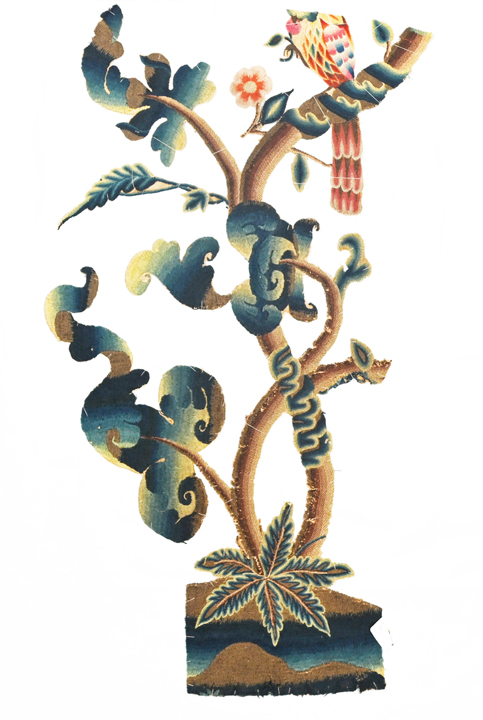
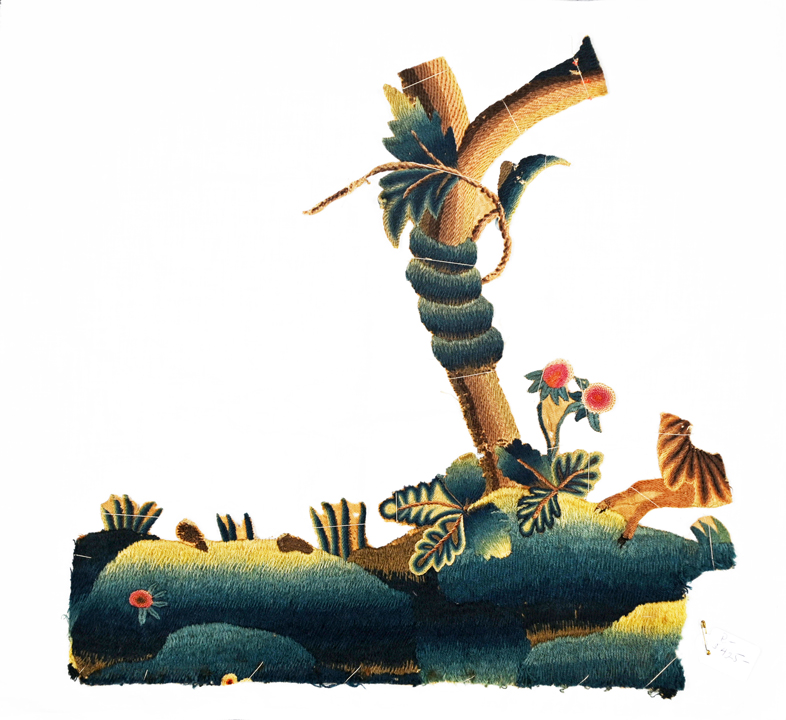
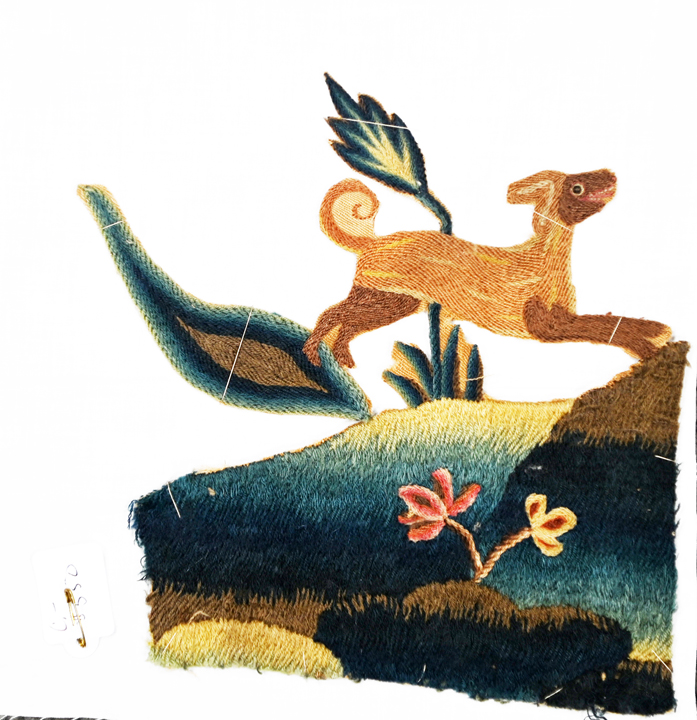
UF923 Fragments from 19th Century Bed Hangings
UF923_7: 17 x 28-1/2 inches, $550
UF923_1: 14-1/2 x 14-1/2 inches, $475
UF923_5: 8 x 11 inches, $550
During the 15th, 16th, 17th and 18th centuries bed hangings were very much in style.
People were afraid to become ill from the cold night air. English bed hangings through
the 17th century were heavily embellished with crewel work designs. These were for the
very rich, and originally began for the Kings and Queens of England. In America we used
yardage of fabrics to achieve this purpose. Everything in my shop is American, however
I could not pass on these. All of the above have been in my private collection for over 30 years.
Embroidery was executed with vegetable dyed woolen yarn onto fine linen. The colors are as
vibrant today as they were hundreds of years ago. Folding over the front to the back easily
shows this point. The craftsmanship is perfect ...the stitches minuscule and always perfectly
executed. Some of the linen was cut away due to its condition. I do have early linen...200 years old...
if you wish this to applique the Crewel work onto.
I am happy to send these, with free shipping, for your approval.
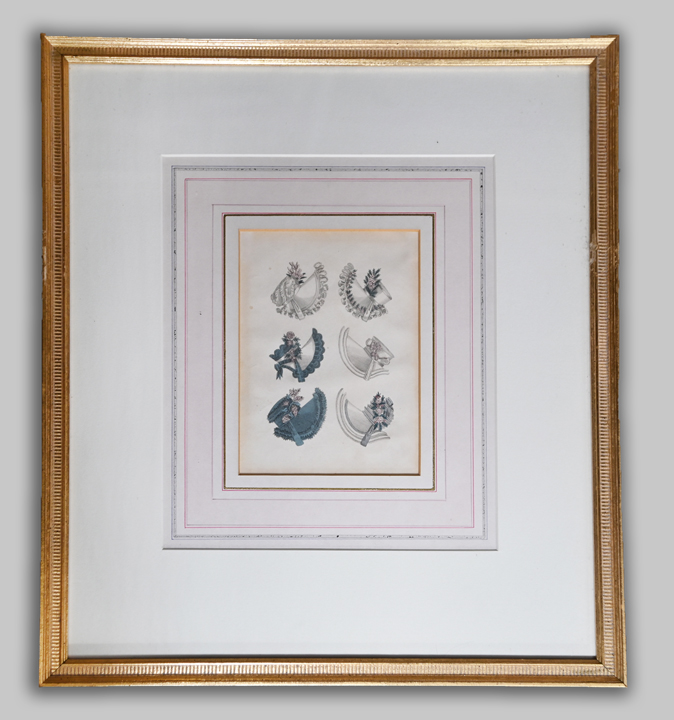
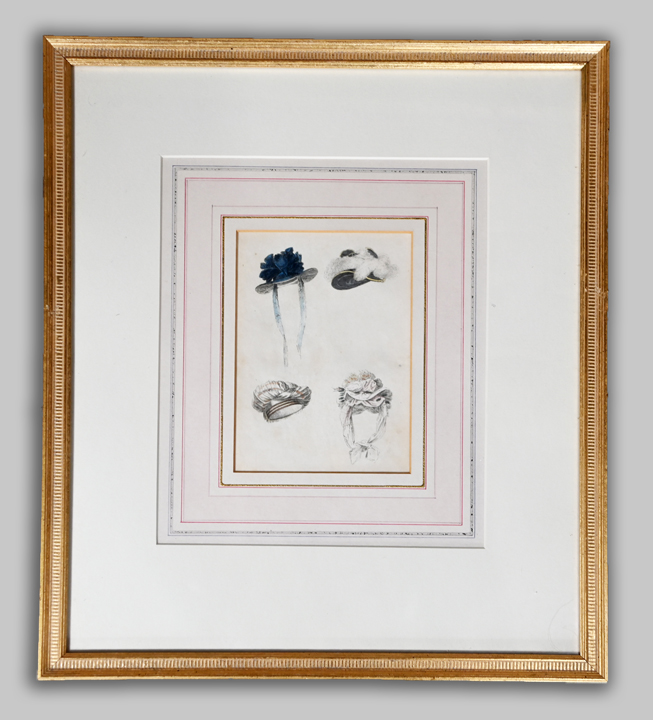
UF922 Framed Pictures of Women's Bonnets
16-1/2 x 18-1/2 inches
UF922A: $295 (6 bonnets)
UF922B: $250 (4 bonnets)
Two pictures, gold framed with double matting, with images of 18th century women's bonnets.
18th Century women's bonnets were an important part of a woman's attire. Whether rich or poor,
women needed head attire to keep warm. Upper class women enjoyed bonnets as their mark of wealth
and their place in society.
These bonnets were usually created from silk and expensive fabrics finished with hand woven ribbons,
silk flowers and even feathers.
Today in New England hats are worn in the summer to keep the sun off and in the winter to keep our heads warm.
18th Century hats or bonnets were a statement, where today they are used for a distinct purpose.
I am happy to send these for your approval with free shipping.

UF921 Signed and Dated Embroidered Sampler
Dated: 1831
Signed by: Emily T. Eddins
17-1/2 x 17-1/2 inches
New England
$1,600
Delicately designed and artistically executed with silk threads on
Linen. From the saying embroidered on this sampler, I am deducing that
Emily was still in her youth..the spring of life.
A proper young lady's education during this time included becoming
proficient in needlework. I am not sure why Emily did not include the
last letter of the alphabet. The birds and trailing vines of flowers
symbolize the spring and youth. Some Samplers have a sad poem...this one
is full of hope and life!
The linen is natural color with silk threads being green, yellow, gold
and brown. At this time in history we know all colors were from
vegetable dyes. The top center has some delicate darning that is
difficult to see.
I have hand washed this wonderful little piece using an organic product.
Now ironed and ready for your framing. Always sent with free shipping
for your approval.

UF114 Linsey Woolsey Quilt Piece
18th Century
12 x 12 (30.5 x 30.5 cm)
$125
A wonderful 12 x 12 inch sample from a walnut dyed 18th century Linsey Woolsey quilt. Perfect for use as a study piece it is a beautiful rich walnut brown with a homespun wool back. One side is pillowcase edged to the homespun back with a double line of hand top-stitched lines. Note the weave repair near the edge using wool thread that we assume was done a very long time ago as that is the traditional way a wool quilt would have been mended. See detail images.

UF116 French Toile Fabric Piece
Late 18th century
36 1/2 x 22 (92.7 x 55.9 cm)
$350
Such a lovely early French toile fabric piece in red on natural linen. We believe it's almost a full repeat of the pattern, the right and top right edges show the end of the print block. Beautiful detail in the printing, please see detail images. A nice size to use as a decorative piece or a wonderful study piece for early fabric connoisseurs.

UF117 Indigo Blue Block Print Quilt Piece
18th century
10 1/2 x 14 (26.7 x 35.6 cm)
$275
A gorgeous early indigo blue dyed block print on this quilt piece. On the back a fabulous print in blue, red, yellow, black, and green. Wonderful for study, Betsey has kept a piece to use in her lectures on early fabrics. See detail images.
The backing on this piece is disconcerting as in reality it is the front of another quilt. At one time someone quilted two different quilts together -- both backed with homespun linen. I assume this was for warmth.

UF100 Antique Redwork Signature Block - Custom Made Feather Pillow
c.1885 Redwork Signature block, newly made into a pillow
19 x 19 (48.3 x 48.3 cm)
$195
A few years ago Country Home Magazine did a wonderful story on Betsey, her antique quilts for sale, and her restoration business. Their designers fell in love with the antique Redwork Signature blocks we had in the shop and made a few fabulous pillows for us using some of their favorites. The Redwork blocks are circa 1885 and are paired with contemporary linen, ribbons and/or buttons. They each have a down feather insert and invisible zipper. Gorgeous and very comfy they are priced individually. This pillow features an apple on a branch in the center of the signatures - please see the detail pictures. A lovely mix of antique and contemporary - each pillow is unique.

UF102 Antique Redwork Signature Block - Custom Made Feather Pillow
c.1885 Redwork Signature block, newly made into a pillow
19 x 19 (48.3 x 48.3 cm)
$195
A few years ago Country Home Magazine did a wonderful story on Betsey, her antique quilts for sale, and her restoration business. Their designers fell in love with the antique Redwork Signature blocks we had in the shop and made a few fabulous pillows for us using some of their favorites. The Redwork blocks are circa 1885 and are paired with contemporary linen, ribbons and/or buttons. They each have a down feather insert and invisible zipper. Gorgeous and very comfy they are priced individually. This pillow features an owl and four different buttons at the corners - please see the detail pictures. A lovely mix of antique and contemporary - each pillow is unique.

UF103 Antique Redwork Signature Block - Custom Made Feather Pillow
c.1885 Redwork Signature block, newly made into a pillow
21 x 13 (53.3 x 33 cm)
$195
A few years ago Country Home Magazine did a wonderful story on Betsey, her antique quilts for sale, and her restoration business. Their designers fell in love with the antique Redwork Signature blocks we had in the shop and made a few fabulous pillows for us using some of their favorites. The Redwork blocks are circa 1885 and are paired with contemporary linen, ribbons and/or buttons. They each have a down feather insert and invisible zipper. Gorgeous and very comfy they are priced individually. This pillow has a patriotic color palette with hand made ribbon flower buttons with jewel centers - please see the detail pictures. A lovely mix of antique and contemporary - each pillow is unique.

UF104 Antique Redwork Signature Block - Custom Made Feather Pillow
c.1885 Redwork Signature block, newly made into a pillow
20 x 20 (50.8 x 50.8 cm)
$195
A few years ago Country Home Magazine did a wonderful story on Betsey, her antique quilts for sale, and her restoration business. Their designers fell in love with the antique Redwork Signature blocks we had in the shop and made a few fabulous pillows for us using some of their favorites. The Redwork blocks are circa 1885 and are paired with contemporary linen, ribbons and/or buttons. They each have a down feather insert and invisible zipper. Gorgeous and very comfy they are priced individually. This pillow has sweet Redwork flowers and leaves amid the signatures - please see the detail pictures. A lovely mix of antique and contemporary - each pillow is unique.

UF105 Antique Redwork Signature Block - Custom Made Feather Pillow
c.1885 Redwork Signature block, newly made into a pillow
20 x 20 (50.8 x 50.8 cm)
$195
A few years ago Country Home Magazine did a wonderful story on Betsey, her antique quilts for sale, and her restoration business. Their designers fell in love with the antique Redwork Signature blocks we had in the shop and made a few fabulous pillows for us using some of their favorites. The Redwork blocks are circa 1885 and are paired with contemporary linen, ribbons and/or buttons. They each have a down feather insert and invisible zipper. Gorgeous and very comfy they are priced individually. A sporty red plaid ribbon accentuates the sweet Redwork leaf embroidery on this pillow - please see the detail pictures. A lovely mix of antique and contemporary - each pillow is unique.

19th century homespun blanket, newly made into a pillow
24 x 24 (61 x 61 cm)
SOLD
Such a great pillow newly made from early homespun. Feather filled with three antique Mother-of-Pearl buttons used for the closing. We didn't know which way to photograph it and finally chose the side with the buttons. The detail image shows the other side. Beautifully made, there is a 2 inch lip including a 5/8 inch fringe around all four sides so the feather insert is 20 x 20. Just lovely.

c.1885
10" x 11"
$55
This little oil painting of Water Lilies, leaves, buds and stems, is backed with flannel. The silk velvet does show some wear, but is still a wonderful little piece of art, either for the Crazy Quilt you are making or to frame as is a little piece of Victorian Art.

c.1885
14" x 14"
$125
A perfect piece for the Crazy quilt you are making, or wonderful to frame. A sophisticated, 120+ year old, oil painting...call for more information.

c.1885
12" x 18"
$175
On Aquamarine blue silk around 1885. A perfect piece to use as a center medallion on a Crazy Quilt of your making...or perfect to frame for a sophisticated piece ofo art.

c.1885
14" x 14" plus 1/2" turned over seams
$135
Created on Brick Red Silk. Perfect for Crazy Quilt or framed as is.

UF920 Quilted Petticoat
c.1845
25" waist (we can make larger)
Massachusetts $2,300
This mint condition quilted petticoat can today be worn as a stunning
skirt! Before any kind of comfortable home heating, we needed to keep
warm and that took some effort. Affluent women would create such a
petticoat as a work of art, even though no one should see it! We indeed
wore many layers of clothing inside our homes as well as outside, in
order to keep warm in the cold weather.
The amazing fabric from the 1840's is the fabric we see. Under the layer
of this fabric and the cotton batting is a backing of dark brown silk.
From the top of the waistband to the bottom of the petticoat the
measurement is 36-1/2". There is a 1-1/2" silk velvet edge to protect
the petticoat from the dirt, etc that maybe on the ground, from wear.
Quilting, in a rope pattern, covers over 3/4 of this petticoat. This
appears to be mint condition and can now become a fabulous skirt..that
no other person will have!
I am happy to send, with free shipping, for your approval.

UF262 Upholstery/Tapestry Quilt
c. 1890
38 x 59 inches
New York
$1,100
I have had this wonderful quilt in my living room for years. Now it’s time for it to go on to someone else. This quilt is comprised of various sizes and shapes of upholstery fabrics from the late 19th century. The dimensions of this tied quilt make it appear to me that it was made for a Victorian chaise lounge. I can picture a Victorian woman, dressed in her lounging robe, lying on a chaise covered with this quilt. :-) The large array of muted earth tones would fit into about 8 or 10 different color schemes. Yes, these are the colors of my living room! Piecing on this quilt is all done by machine with the binding turned over from the back and then hand stitched down. The backing fabric is an earlier muted burgundy, beige and brown stripe. This piece is hand tied and has been professionally hand washed by Betsey and is in wonderful condition. If you choose to hang it on your wall, it can be hung in either direction. I had it positioned over the back of my sofa in an easy to grab place for a covering. This very sophisticated 19th century quilt is all set to be seen on approval.

10 x 10 inches
$25
White with pink roses

9 x 10 inches
$45
White with pink rose buds

9 x 12 inches
$225
Dark with pink flowers

7 x 9 inches
$85
Dark with Japanese maple leaves

14 x 14 inches
$135
Red with white dogwood

14 x 14 inches
$175
Beige with purple iris

10 x 19 inches
$175
Olive with pink water lilies

14 x 14 inches
$225
Royal blue with white daisies

11 x 18 inches
$225
Black with white roses, butterfly

10 x 11-1/2 inches
$55
Red with white water lilies

12 x 18 inches
$225
Blue with pink flowers, beach roses

11-1/2" tall
$65
Victorian Long Tan Colored Woolen Spat. 12 buttons. Appears to be unused.

c.1890
$25 each
Silk Cigarette Premiums, more pictures are available on request

UF287 Hand Loomed Floor or Bed Rug
c.1930
70" x 80"
Maine
$425
The months that weaving this piece would have taken are unimaginable.
First the cotton threads needed to be created...then the hand weaving on
a 36" loom! Again we have a piece that was too precious to use ..lucky
for us..now we have an unused, natural colors of white, rug for your
cottage or any room, in any home, that one wants to be white and cheery.
I have been told that some of these "Rugs" were actually used as bed
coverings, much needed to keep warm in the cold winter months of Northern
Maine. A woolen quilt covered by this piece would have been perfect to
create a cozy, comfy and warm bed!
Never used and now washed and ready to be sent for your approval ...with
free shipping.

UF286 Hand Loomed Rug Runner
c.1930
34" x 166"
Maine
$425
How perfect this white hand loomed runner would be for your summer
cottage or any room in any home you wish to be bright and cheerful.
Woven from homespun cotton threads that have been created in an
assortment of thickness in natural shades of whites. It is amazing to me
the weeks.....or months this runner would have taken to weave...and then
because it was so treasured...never used! Now, almost 100 years later
this runner will be used and enjoyed.
I am happy to send this runner, for your viewing and approval, with free
shipping.

Q8998 1893 Chicago Exposition / World's Fair Quilt, with Provenance
c.1893
79 x 80 inches
Found in Pennsylvania
$2,900
An amazing find, this quilt's focus is the 1893 Chicago World's Fair,
also known as The World's Columbian Exposition, which was designed to
commemorate the landing of Columbus in America. Executed using lengths
of printed fabric made specifically for the Exposition for use as bunting,
handkerchiefs, and other memorabilia.
The front of the quilt is wholecloth; three vertical lengths of printed
fabric hand pieced together to create the quilt's top. The 5 ¼ inch
burgundy striped border is also hand pieced and folds to the back forming
a 1/2 inch hand stitched binding. The quilt has a puffy batting that is
smooth and without any shifting, lumps or bumps. The quilt is top tied
using, of all things, thin hemp-like ties that add to the uniqueness and
overall design of the quilt. The backing is a great black and red cotton
calico-see detail images. Stitched to the back of the quilt is a hand written
note on cotton stating the maker's and recipient's names along with the date
of the gift: December 25, 1893.
There is an interesting side note regarding the history of the 1893 Chicago
World's Fair itself.
As mentioned, an interesting side note to the 1893 Exposition and its history!
Our lovely quilt remains unmarred by any connection to the more gruesome aspects
of a marvelous and historical exposition. We can assume our talented quilt maker,
whose name will go to the buyer upon sale, chose other accommodations during her
visit to the 1893 Chicago World's Fair.
This unique quilt has been professionally hand washed by Betsey, is in excellent
condition, and can be shipped to you on approval for private viewing. Please ask
Betsey for more details.
This quilt already has sleeves sewn on the back in case you would like to hang it as art on a wall.

UF64 Silk Edwardian Formal Dressing Gown
c.1890
apx. size 10 to 12
New York
$625
After the Civil War, the passing of Queen Victoria and through and
after WW1, most families were in mourning for a son, brother or husband
who were lost in one of those wars. Many women were dressed in black..day
and night.
Seen here is a formal "Embellished silk Dressing Gown Robe" that would
have been part of a very wealthy woman's wardrobe. A servant would
assist in the preparations for bed. Undressing, dressing, combing of her
hair and whatever assistance the Lady of the House would need. Have you
seen "The Guilded Age" or "Downton Abbey"? This is such a garment that
they would have worn, or others in a similar social position would have
enjoyed. Today this amazing garment could be worn to a formal evening
out and be the hit of the town!..worn at home for entertaining......or
just displayed in one's home...The embellishment on this robe is so
sophisticated...just beautiful!
Ready to be sent, for your approval, with free shipping.

UF906 Antique Hand Woven Embroidered Linen Fabric
c.19th Century
27" x 63"
Origin Unknown
$850
I am captivated by the hand embroidery on this fabric. The designs are
reminiscent of the 18th century, although I do not believe this piece is
that old...Possibly the second half of the 19th Century.
This textile was created from hand woven linen and then hand dyed in a
color that is an orange/Turkey Red. The delicate embroidery was
executed in black, white and a reddish orange. You can see some
embellishments that she has not finished. The designs are reminiscent of
a much earlier time. We have flowers and what I believe is a hanging
bee hive. All embroidery is beautifully done. The fabric is selvedge to
selvedge with a 27" width.
I can see this beautiful piece adorning a special place in one's
home...either on the wall or on a table.
I am happy to send this special unusual piece, for your approval, with
free shipping.

19th Century
$125

$75

Dated 1812
6" x 8-1/2"
$18 + $2.50 postage
Two women and a child "Modes de Paris"

c.1880
$140
Victorian Era, Silk Velvet + Linen

Early 19th Century
13" x 13"
$325
Some wear (back excellent condition homespun in mustard dye)


Late 18th Century/Early 19th Century
A. 12-1/2" x 13-1/2" Quilted
B. 13-1/2" x 18" Quilted with Hearts
A. $450
B. $475
Mustard dyed LInsey + Deep Rose Calamanco
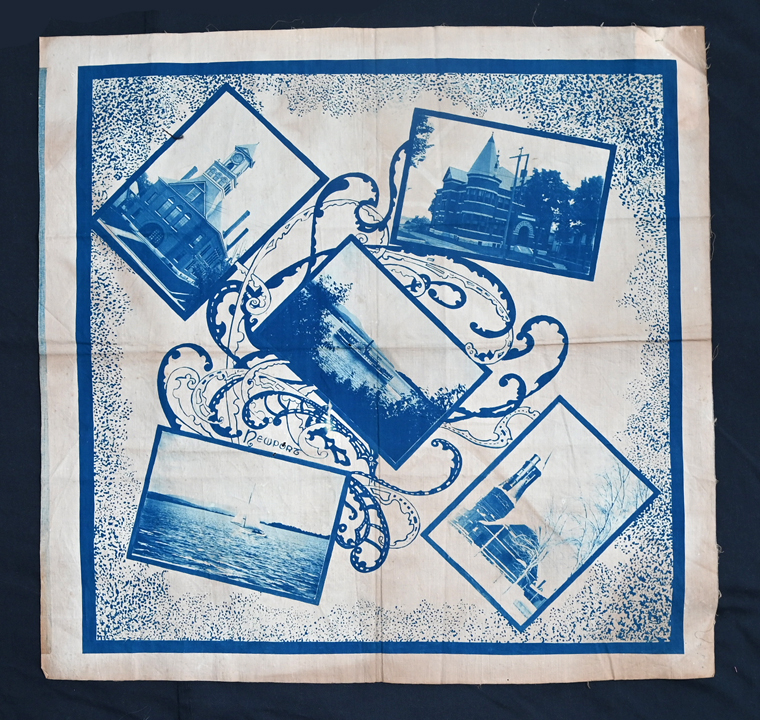
c.1885
18" x 18-1/2"
$325
Commemorative Scarf. Excellent Condition.
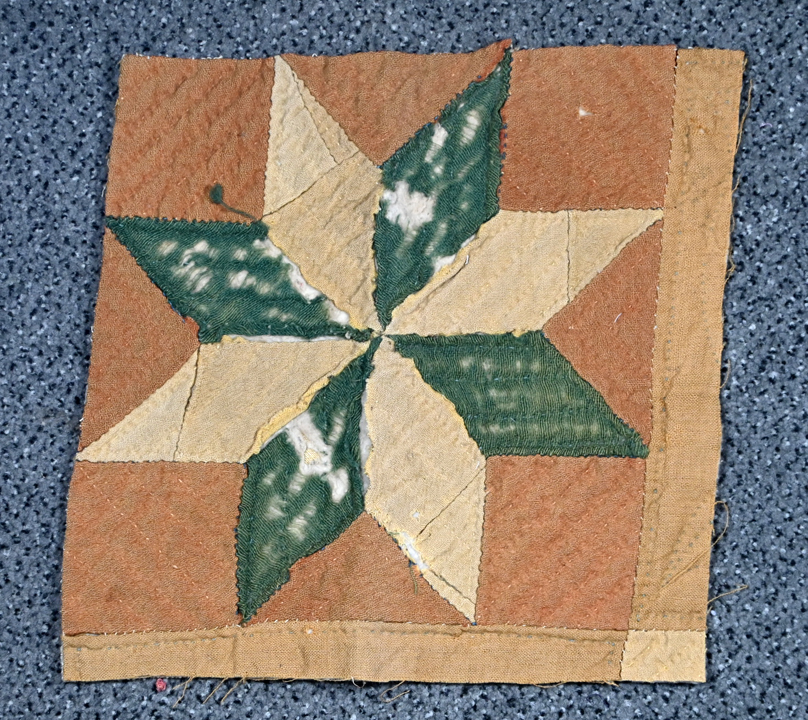
Late 18th Century or Early 19th Century
9-1/2" x 19"
$250
Back homespun/homedyed wool with moth holes!
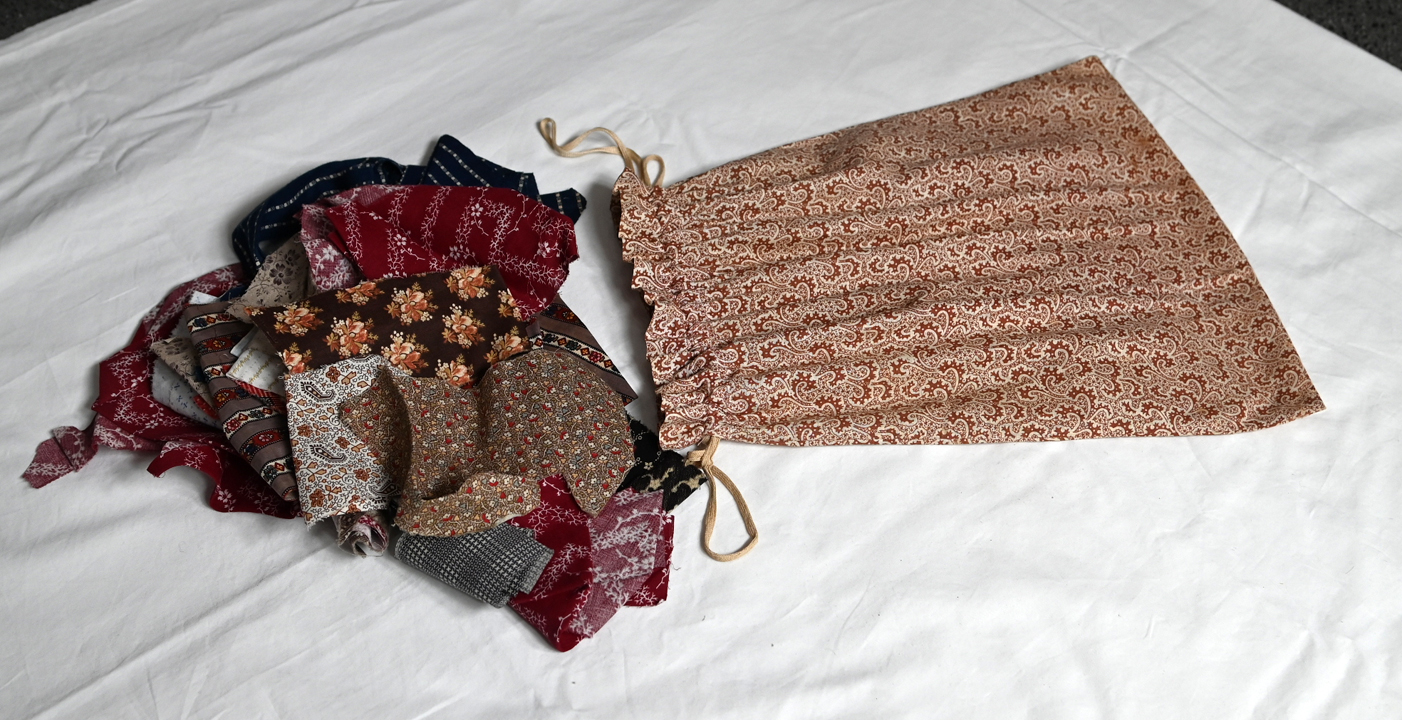
c.1870s with earlier fabrics
14" x 16"
$325
Unused condition fabrics: over 2 dozen pieces.
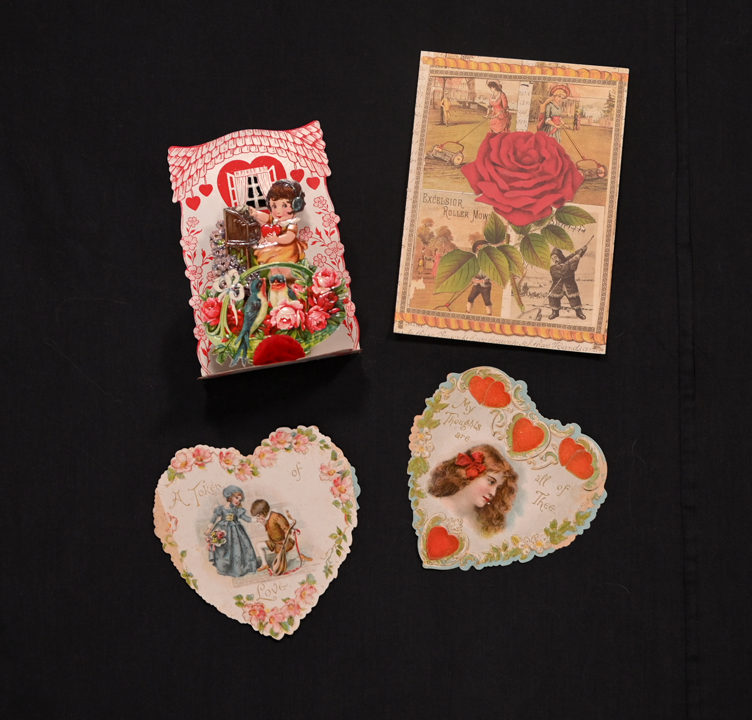
4 for $75
Excellent Condition.

19th Century
2-1/2" x 3"
$125
Wonderful Condition.

c.1875
10" x 10" + 1/2" trim all around
$125
Excellent Condition.
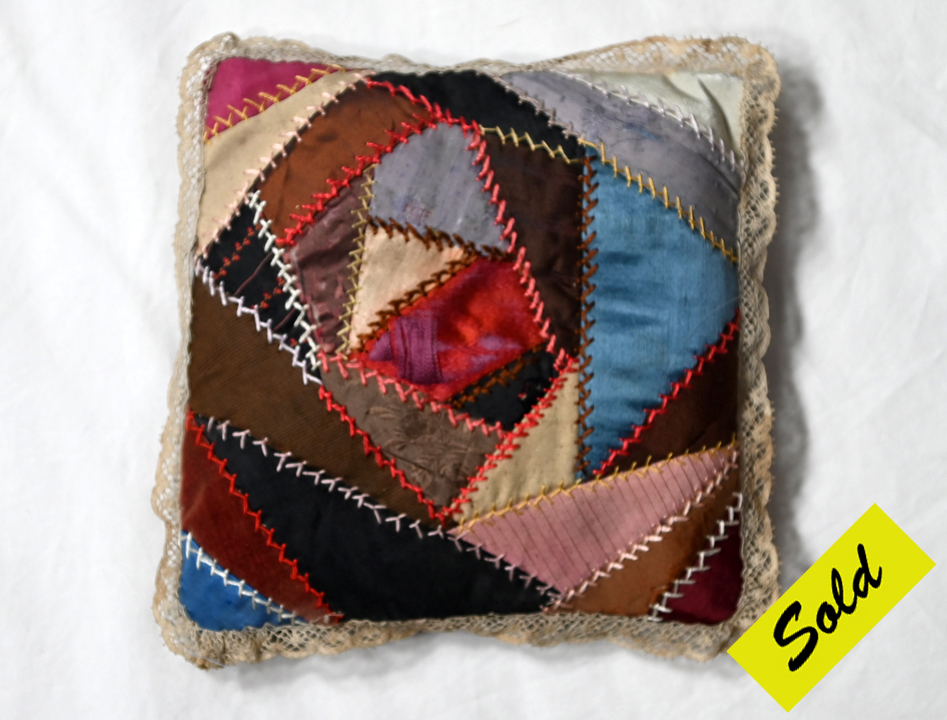
c.1880
7" x 7"
SOLD
Wonderful condition, with 1/2" lace edging.

UF63 Woolen Crewel Work Valance
c.18th century or earlier
8" x 58"
Origin Unknown
$850
This amazing early valance is Crewel Embroidered with vegetable dyed
woolen yarn on natural color homespun woolen fabric. One edge is
selvedge while the top edge is turned over and hemmed with a running
stitch. There are various shades of blue...some being Indigo..all are
vegetable dyed that are used for the Crewel embroidery. There are some
ancient moth holes and ancient patches that you can see from the back.
This beautiful and rare 18th century or earlier valance can still be
used today or framed as an example of, believed to be Jacobean woman's
handwork. There is something very special about it...!
I purchased this piece over 20 years ago and am now ready to have this
textile find another home.

UF55 Edwardian "Dickie"; Star Of David Hidden Buttons; Jewish Memorabilia
c.1900
Full length 20", width 8" at widest point
New York
$325
Do you remember when "Dickies" were in style? I do 😄 However this
one pre-dates when I wore them by well over half a century. This is an
example of women being proud to be Jewish, but hiding the fact.
Personally, I have never seen buttons with a Star of David on them.
These are very complicated brass buttons with a raised Star and a
circumference of shiny stones...Each of the 14 buttons measure 1/2" in
diameter.
The entire piece looks hand made and never used. The 1-1/2" very
elaborate fringe is a darker shade, in the same hue as the fabric.
What a rare collectors piece of Jewish memorabilia in complete original
condition.
This "Dickie" may be sent for your approval, with free shipping.

UF54 Exquisite Victorian or Edwardian Trim
c.1890-1925
3" x 50"
$115
This exquisite very elaborate woolen woven chenille trim would make an
amazing addition to a Crazy Quilt, table runner or just to collect.
The colors of the yarn are brick red, gold and burnt umber. A very
sophisticated color palate.
There is one piece measuring 3" X 50". I believe this piece is machine
woven although it looks as if it was executed by hand.

UF53 19th Century Trim
c.19th Century
4 pieces, each measuring 13" x 2"
$95 for all 4 pieces
Woven coat trim in Ecru, Turkey Red and Khaki.
Every strip is turned under on each end, with a hand finished buttonhole
on one end of each piece. These strips are unused, never making it to
the desired apparel. Trim only wealthy could afford.

1. c.1860, 1-1/4" wide unfolded, continuous 263" long, vegetable dyes, $125
2. c.1845, 1-1/2" wide unfolded, continuous 316" long, vegetable dyes, $120
3. c.1820, 1-1/2" wide unfolded, continuous 173" long, All Brown $145
c.1820, 1-1/2" wide unfolded, continuous 161" long, Floral, $145
4. c.1885, 1-7/8" wide unfolded, continuous 66" long, Light Indigo with White Dot, $65
c.1885, 1-7/8" wide unfolded, continuous 65" long, True Indigo Dye, $65
5. c.1885, 2-1/4" wide unfolded, continuous 61" long, Same Light Indigo with White Dot, $65
c.1885, 2" wide unfolded, continuous 65" long, True Indigo Dye, $65

6. c.1835, 1-3/8" wide unfolded, continuous 263" long, vegetable dyes, $145
7. c.1835, 1-3/4" wide unfolded, continuous 284" long, vegetable dyes, $145
8. c.1840, 1" wide unfolded, continuous 243" long, Chrome Orange, Vegetable Dyes, $145
9. c.1850, 1" wide unfolded, continuous 326" long, True Indigo with Tiny White Dots, SOLD
10. c.1850, 7/8" wide unfolded, continuous 343" long, Over Dyed Green Calico, $125

11. c.1820 or earlier, 5/8" wide, continuous 105" long, Woven Binding Continuous Piece, $125
12. c.1820 or earlier, 5/8" wide, continuous 187" long, Woven Binding Continuous Piece, $175
13. c.1840 or earlier, 7/8" wide, continuous 146" long, Continuous Piece, $145
14. c.1820 or earlier, 1-1/4" wide, continuous 72" long, Continuous Piece, $85

UF51 Man's Bathing Suit, from Ocean Bathing Suit Co.
c.1920
New York
$225
Two buttons on one shoulder when undone would help to put on this woolen
men's Flapper Era bathing Suit.
The gray color makes it perfect to frame with today's decor. The suit
measures 18" at widest point by 31" in length.
We have organically hand washed this wonderful find. Please request to
have it sent, with free shipping, for your approval.

BTG83 Broderie Perse Fragment
c.1800
33 x 35
New England
$2,400
What an opportunity to acquire a very early center medallion from a Broderie Perse quilt and in perfect condition!
This piece is the center of an actual Broderie Perse quilt created between 1780-1810.
The Broderie Perse technique was developed for the Anglo-American quilter during the late 18th century.
Fabric for the design came from India where some of the best fabrics in the world were woven,
designed and printed. From a printed fabric quilters would cut out various ententies..animals, birds, flowers, etc.
then applique these onto the body of the quilt. These pieces are sometimes stuffed and as on this very
sophiticated piece painstakingly embellished around each piece.
This Center Medallion contains a large center block of an early block print taupe floral glazed chintz set on point.
This block is surrounded by chintz birds and butterflies meticulously cut out and appliqued onto off-white homespun linen.
The hand appliqué stitching is phenomenally dense, and the entire piece has been hand quilted in chevrons set 1 inch apart.
The same chintz used in the center block was used for the 1/4 inch separately applied binding, and the backing is the same
off-white homespun linen as was used on the front. This Center Medallion of a Broderie Perse quilt is as I found it.
What a find in a perfect size for wall art! A true collectors piece and ready to be sent, with free shipping, for your in-home approval.

B31 Folksy Western Motif Bates Bedspread
c.1955
75 x 92 inches
Maine
$375
Red, white, and blue are the colors used in the construction of
this pleasingly graphic western motif spread. A few of the machine woven
designs seen here are the rising sun, flying birds and numerous cattle
brands. Each ranch has their own individulisic design for a branding
iron. When cattle roamed the open range the brand was the only way to
tell which cattle belonged to whom.
This spread can be used for its original intent as a bed spread or for
delightful pillows...or both with a twin bed. Another idea is this
artistic spread folded over a bar would make a fun piece of art on your
wall either full size or folded in halves, thirds or quarters.
This lower price reflects some shading on the spread.
Organically hand washed and ready to be sent for your at home approval.

UF100 Odd Fellows Overshot Summer/Winter Carpet
c.1890
62 x 66 inches
Found in Pennsylvania
$2,200
Created on a 35" loom; finely woven with thick black and red woolen
threads. Odd Fellows symbols are the format for the design of this
creation. I enjoyed using "Google" to read about the deeper meanings of
the many Odd Fellows symbols. An over simplified version of these
symbols is the importance in life of love, industriousness, truth,
and acceptance of one another.
This c.1890 amazingly graphic piece of art was actually carpet for the
floor of a 19th century home or possibly the actual Odd Fellows Lodge.
Strips of 35" wide carpet were sewn together to create the needed room
size. This carpet, a perfect piece of art for your wall, is not quite two
full widths: one full and one apx. 3/4 width, hand sewn together. Please
look at the closeup sections by clicking the above photo. Where have you
ever seen 19th century art in red and black...a sought after and hard to
find color combination.
Betsey has organically washed this carpet so it is clean for your
perfect wall space. We can also apply "sleeves" so the "carpet" is ready
to easily hang. Please call for more details.

UF249 Center Medallion Victorian Crazy Quilt Pillow Cover
c.1885
27 x 27 inches
Massachusetts, Name upon sale
$950
Created from wide strips of silk and or ribbons, this center medallion
Crazy Quilt pillow cover appears to be much larger due to the design. The
center motif is a wonderfully embroidered bouquet of flowers tied with a
ribbon. All embroidery stitching is executed with perfection. With
meticulously stitched embroidery
work this very talented woman created a double row border. The wide
cotton sateen ruffle was created to take regular use. The backing is created
to insert a pillow.....or this perfect condition piece of art could
adorn your wall...
Always sent for your approval at my expense.

c.1945
Fits a small child
USA
$65
This adorable little apron was never used.
Created from a c. 1940's conversation print, this apron has two long ties...
long enough to make a bow in back.
Perfect as a gift to be used or framed..

1876
approx. 16 inches
USA
$150 - $225
Created from antique quilts and finished with antique lace or trim....
I only have a few...mostly from 19th century quilts, and they measure apx. 16 inches top to bottom....
organically washed and ready to be viewed at home...

UF205 Amish Stumpwork
Early 20th century
23.5 x 25 inches
Lancaster, PA
$285
A beautiful and rare piece of Amish textile art that would be a perfect wall hanging or folk art center piece for a table. Wool stumpwork tulips are arranged in a wreath-like formation in perfect Christmas colors. Executed on linen, maybe home-woven. A delicate 1/4" crocheted cotton lace edge frames the whole and is a lovely finishing touch. It appears to be hardly used with one slightly shaded area in the center which can be seen in the photograph. Colorful, dimensional and funky this is a fabulous piece of folk art for your home.

CONCLK2 Original Folk Art Embroidered Table Embellishment
c.1890
28 x 38 inches
Found in Maine
$2,900
In complete original condition, this creatively embroidered table embellishment is comprised of 24 7” blocks with wool embroidered motifs on black wool. We have a swan, which to me represents a relationship lasting a lifetime, flowers and leaves representing spring, summer and happiness. There’s a bird with “AM” embroidered on its wing. Created in the 1890s, it appears that the maker was incredibly creative and probably came from a less affluent family. The backing of each block is a much earlier homewoven fabric. There are sleeves or what are called pockets sewn on the back making it ready for hanging. Equally beautiful would be as a center focal point of your dining room table...Ready to be sent for your viewing and approval.


I call feedsacks the original baseball cards. The reason I say this is because in the 1920’s, 30’s and 40’s people would try to buy more of a specific print or solid to finish their project...either clothing or a quilt. A consumer would purchase a brand in order to have the fabric. Some of the ones shown here are collected more for the brands than to use..I have dozens of calico feedsacks for sale. These sacks are very collectable. We do have in the shop some duplicates, both of the ones shown and calicos or conversation prints. The term feedsack is a misnomer as it covers many sack uses of these bags from grains, flour, corn, sugar, salt, animal feed and others. Prices vary. Call or email for more information

Mid-1800s
$350
An affluent woman's sewing table from the mod 19th century. At that time most hand work of ladies of stature was done on their laps using a wooden hoop. This table would hold all their thread, pins, needles and other sewing tools of that era. Today this becomes a beautiful accent table with history.

UF265 White Homespun Linen Embroidered Coverlet
c.1860
91 x 96 inches, plus 3-1/8" embroidered edging and 2" crochet netting on one side, and 8-1/2" rounding 2 corners
$2,200
This home spun linen coverlet is an extraordinarily rare piece. To find one such coverlet in this condition is amazing! There are three strips of homespun linen measuring 30” selvedge to selvedge stitched together to create the size needed. The width of each piece was dictated by the width of the loom used to weave the linen fabric. The embroidery work has been executed in cotton thread on linen and is very sophisticated in nature and incredibly time consuming. A woman's mark of excellence was her "hand work". A wonderful cover for any double or queen size bed in summer or over a comforter in winter. I know to date the finished creation to 1860 because the top edge has been turned over and stitched down by machine. The linen may have been woven at an earlier date. The finishing detail seems strange to me because of all the intricate embroidery and hand made fringe....or did another woman embroider a much earlier piece as indicated by the cotton embroidery thread and not the use of linen embroidery thread.

UF260 Variable Star or LeMoyne Star Wall Hanging
c.1845
19 x 20 inches
New England
$425
This was originally a bigger quilt. This Variable or LeMoyne Star wall hanging came to me in exactly this shape and condition. The body of the quilt is apx c.1845. Somewhere around 1860 someone took a piece of the original quilt and made a pillow cover out of it using a heavy duty striped cotton ticking as the back. It has never been finished or used as a pillow. What we have here is a wonderfully graphic wall hanging. Looking inside you can see the amazing fabric that was the backing of the original quilt. The blocks measure apx 7 x 7-1/2”, the center squares measure 4” and the triangles are 2 x 2-1/2 x 1-3/4. One edge of this little piece has been turned over 1/8” fo a binding and finished. This entire piece was created by hand before the sewing machine was invented. Even though this is in the size and shape of a bassinet quilt, by doing some detective work, we know how and what it was made for.

UF261 Needlepoint Seat Cushion Covers
c.1960s
24-1/2 x 28-1/2 inches
New England
$450 set
The sophisticated art of needlepoint has been executed for hundreds of years. The women who participated in this art form had to have had an unbelievable amount of patience. I can’t imagine how long each seat cushion took to make.... certainly months. We have birds, flowers, vines, leaves and more all perfectly executed. There are 6 needlepoint cushions, 5 in perfect condition and 1 with an area with color missing. Today they could again be used as seat cushions or backs and seats for small chairs or as the most sophisticated and exquisite pillows. The sizes are apx 24-1/2 x 28-1/2" plus 1/4” edge turned under, 18" x 29” could be easily cut or 19 x 24” completely clear. If interested please call ....these can be sent on approval.

UF258 Woolen 48 Star American Flag
c.1920s or 1930s, possibly older
59 x 93 inches (apx. 5 x 8 feet)
New England
$500
The stars are free hand placed on the indigo blue background. When one looks at the stars they appear to be dancing and whimsical. The stars are linen and the indigo blue and red and white stripes are wool. Yes, there are moth holes. I always tell people to be careful when buying a wool piece without moth holes. The moth holes are a sign of authenticity. A wool antique without moth holes would be suspicious. The indigo background measures 41" x 33”, the stripes are 4-1/4“ wide and the stars measure 3” tip to tip.
UF258A Woolen 48 Star American Flag
c.1945 or earlier
95 x 176 inches (apx. 8 x 14 feet)
New England
$Ask for price
This flag is too large to photograph. I believe this one is a WWII vintage flag. The stripes are 7-1/4“ wide and the stars measure 4-3/8” tip to tip.

UF257 Victorian Glass Bead Embellishment
c.1885
$225
Thousands and thousands of Victorian glass beads hand strung to create embellishments. These were removed from an 1880’s Victorian evening gown. There are some embellished pieces that are ready to be applied to whatever you wish. They can be applied to clothing, pins and hats. There are at least two pounds of Victorian glass beads in total.

10 x 10 inchdes
$25
Hand quilted, hand embroidered and all ready to be filled with a little pillow. Original unused condition and professionally hand washed by Betsey. Is this Winnie-the-Pooh holding on to a branch attempting to get some fruit from the tree?

c.1930
$15

c.1890-1920
$15 for two

c.1890
42 x 103 inches
Origin unknown
$400
During the Victorian era when we would have finished embellishing, it appears that they just started. This cotton chenille drapery panel, is c.1890. The embellishment along the top, bottom and sides is all raised chenille. It’s just beautiful. The photograph does not do it justice. Some of the tassels are not in perfect condition, and there is some wear on this piece. However, the fabric is amazing and could be used to make pillows, to upholster a chair, or as a throw on a couch.

Late 19th century
41 x 100 inches
Found in New York $350
I do not know what this was originally used for. Possibly yardage for drapery fabric. Today it can be used as a tablecloth, pillows, drapery fabric or anything you wish.

UF223 Fulton Seamless Grain Bag w/Eagle
c.1930-1945
20 x 43 inches
Pennsylvania $85
Because the word war is stamped on the side, is it possible that this was meant to be used during WWII? In barely used condition, with black eagle and lettering and blue and brown stripes. There are some very faint stains.

UF222 Cotton Tow Sack
Mid 19th century
18 x 50 inches
Pennsylvania $350
Cotton balls were picked by hand and put into this sack. A strap was fastened on the sack and around the picker’s shoulders. This sack has never been used. If the seam was undone and the sack opened it would measure the full width of a homespun piece which would be 36” selvedge to selvedge.

UF221 Hand Carved Folk Art Figurines
King: 2 1/2” x 16”
Queen: 2 5/8" x 13 1/4”
19th century
$600/pair
I was told these came from a gambling hall in Colorado in the 19th century. Hand carved, hand painted and believed to be mostly original paint.

UF216 Full length cotton nightgown /lounge wear with crocheted yoke
c.1930s
$65
The crochet is 9 inches long from the shoulder front and back. The sleeves have 1 inch of crocheted trim.

UF36 Linen Homespun Bag
c.1800
17 x 22 inches
New England
$350
This bag is 22 inches selvedge to selvedge on a piece of fabric that runs 34 inches long. Natural homespun linen was a New England fabric. It would take two years to make this, starting with planting the seed needed to make the flax for the linen. There are many gauges of linen thread. The finer gauge would be used for sheets and table cloths. The heavier gauges were used for bags, such as this one, or weaving with wool to make a Linsey Woolsey quilt.

UF35 Unusually Fine Wool Challis Paisley Shawl with Black Center
c.1865
64 x 126 inches
Found in NY, believe to be created in France
$1,250
During the 19th century women wore shawls not only for fashion but for warmth. These were our 19th century coats. Women would wrap the shawl around and around and drape it nicely. The black center of this paisley shawl is a beautiful 19th century black wool challis, which does not photograph well. (It’s a much richer black than shown in the photo). When you are not using this shawl as a drape on the way to the theater, it could be used as a banquet tablecloth in your dining room.
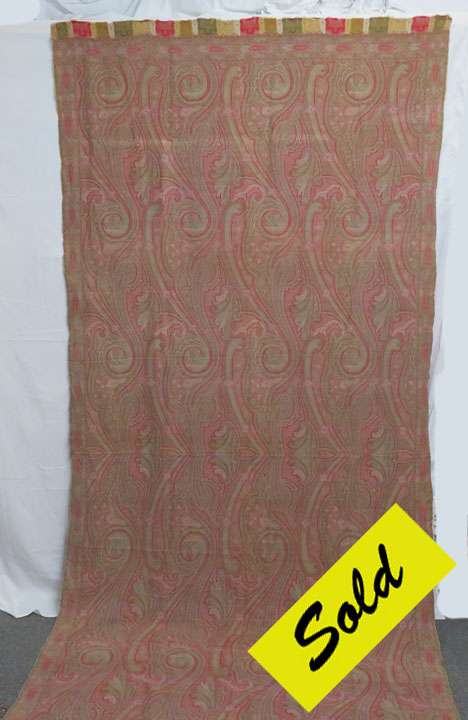
c.1860
61 x 127 inches
Found in NY, believe to be created in England
SOLD
During the 19th century women wore shawls not only for fashion but for warmth. These were our 19th century coats. Women would wrap the shawl around and around and drape it nicely. This is exceptionally long, measuring 137 inches. Because of the large size of this shawl, it could also be used as a banquet size tablecloth. Muted moss green, beige and red, the overall look is sophisticated. Fabulous condition.

UF39 King Size Pillow Case
late 19th century
9 x 30 inches
New England
$150
The crochet embellishment is beyond gorgeous. In perfect condition. For whatever reason, this has never been used.

somewhere between 1930’s and 1950’s
11 x 18 inches
New England
$30
This 100% cotton feed sack was used as packaging for an extra pair of suit pants.

UF218 Beautiful cotton percale slip to be worn as a skirt
$175
The bottom 9 inches are comprised of 3 1/2 inches of exquisite crochet work and 2 inches of percale. 30 inch waist. Appears to be executed with a 0 size needle.

UF215 Full length cotton petticoat that can be worn as a summer skirt
c.1890-1910
Was $250, now on sale for $150
The bottom 15 inches of this “skirt" has wonderful layers of lace and trim. 30 inch waist.

We had three identical bags, now only 1 left...
c.1963
approx. 21 x 37
Mingo, Kansas
$325
Yes, we know this piece only dates back to the early 1960’s, which is new in Betsey’s world, but isn’t it wonderful? The Bambino Bean company used these 100 pound burlap bags to package pinto beans until Babe Ruth’s estate stopped the use of the Babe’s image. Betsey bought these five bags on one of her trips across the country over 10 years ago, and then forgot about them until she was up above the barn rummaging for treasures. So, whether you are a Red Sox fan, a Yankee fan, or just a fan of the game…one or more of these pieces would be perfect to add to your collection, and would look great on the wall as you cheer on your teams!

UF208 Confetti Rag Rug
c. 1920
23.5 x 36 inches
Hampshire
$1,900
Betsey found this fantastic piece in New Hampshire. It showcases an exuberant confetti-like arrangement of wool and cotton fabrics. This beautiful textural and very graphic piece is perfect for that special place on your wall. It was purchased already mounted and ready to hang as a very unique piece of textile art.

UF38 Delicate Linen Tablecloth
c.1930
36 x 36 inches
New England
$28
Embellished with embroidered cross stitching. The edges are finished with a blue button hole stitch. There is a running chain stitch all around the tablecloth 3 inches from the edge creating a border.

UF213 Early 20th century slip with cotton Fleur De Lis patterned trim
Early 1900s
$150
Can be worn as a summer skirt. Draw string waist. Max width 38 inches.

BT-G Collection Mounted Penny Rug
c.1890
42 x 73 inches
New England
$2,400
This wonderful wool penny rug consists of 3 ¼ inch diameter circles of felted wool each with hand appliqued felted wool flowers accented with fine wool hand embroidery. The 4 inch long scallops, or tongues, along the entire edge also contain felted wool appliques, embroidery and a crocheted edging.
Professionally mounted on a wood frame covered in black cotton and ready for hanging. We show it vertically here, however it hangs as a horizontal work of art in Betsey's large kitchen.

UF3 Stars and Stripes Bunting
c. WWI or WWII era
10 feet long
Maine
$475
This stars and stripes bunting is from either WWI or WWII, I am not sure which. I found this piece in Maine. Prior to the advent of paper decorations, we would use bunting to decorate for elections, presidential birthdays, and other political celebrations.

UF219 Child's Poodle skirt
c.1950s
$75
Child’s 1950s Cotton Poodle Skirt embellished with “Love me…” Buttons in the back. Appears to be sized for a ten year old.
Rocky Mountain Quilts Shop Hours
Shop Open Year Round
Hours: Mon, Wed, Fri, Sat 10-4
Other times: Call for Appointment or take a chance and call from the driveway 207-363-6800.
Hours: Mon, Wed, Fri, Sat 10-4
Other times: Call for Appointment or take a chance and call from the driveway 207-363-6800.
Payment Methods:
Rocky Mountain Quilts gladly accepts cash, checks, Visa, Master Card and American Express. Bank wire transfers are an easy method of payment for both domestic and international sales. If you are traveling, we will be happy to ship your purchases via FedEx at your convenience.
Contact Us
Telephone - for orders or questions -
1-207-363-6800
Email - betsey@rmquilts.com
Shipping FedEx address -
130 York Street
York, Maine 03909


